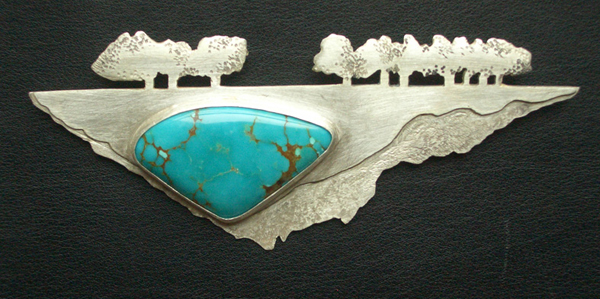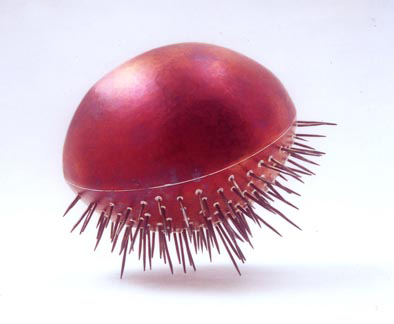Contemporary jewelry is, with just about 10 years of age, a comparatively young field in China. But, if the missionary zeal and perseverance of the few key players I interviewed is anything to go by, we can be certain that Chinese jewelry will play an important part in the contemporary scene just a few years from now.
China has seen a tremendous amount of changes in the past 30 years. Western headlines notwithstanding, these changes are not limited to economic growth, and they significantly influence Chinese society and culture in multiple ways. Nor are they easily graspable, if one is reliant on Western media. China still remains a large, but unknown place to most of us who have never travelled to or lived in this country.

Most of my research over the last few months has been done in a mixture of Chinese and English, and interviews were rarely conducted in anyone’s native language. This, however, was not my biggest challenge. Understanding my interviewees means getting past differences in culture and communication behavior that are difficult to overcome and not always easy to identify. The international contemporary jewelry scene often calls for recognizable cultural markers. In order to notice and appreciate these cultural references, some knowledge of the culture it stems from might be required. For example, observing Chinese jewelry from a Western cultural background, one might see an aesthetically pleasing work but miss out on the meaning behind it. As a result, I have tried, as much as I could, to provide some background information on Chinese culture, philosophy, and general way of thinking.
I sincerely hope that by sharing some of my fascinations about this “new universe,” I will also spark some interest in Chinese contemporary jewelry, and thereby foster some exchange among Western and Chinese contemporary jewelry artists in the future. This article is the second in a series that aims to bring Chinese contemporary jewelry closer to the Western audience.
Anja Eichler, Shanghai, China, October 2013
Shannon Guo is the head of the jewelry and metals studio in the College of Fine Arts at Shanghai University and curator of the Twocities gallery in Shanghai.
Anja Eichler: I would first like to ask you about the recent history of jewelry in China. As I understood, China had a long and rich tradition of jewelry until the Cultural Revolution. How did jewelry make a comeback after that?
Shannon Guo: I think it started after 1978. After Deng Xiaoping announced the “open door policy,” a lot of Western enterprises started coming to China and hired Chinese companies to produce their designs. For about 20 years, from the late 70s to the late 90s, most of the jewelry business revolved around producing for Western companies. There was very little original design produced locally. With the financial crisis some years ago, some factories no longer had business from the West, so they had to seek their market in the mainland. They stopped just producing for the Western companies and started to look for designs that were suitable for the Chinese market.
Generally speaking, how is jewelry perceived today in China?
Shannon Guo: The majority of Chinese think of jewelry as an investment or as a means of showing off their status and money. I think that, in the past, customers mostly bought Western jewelry from big brands, such as Cartier or Tiffany. Only recently did we see a minor shift in attitude. Some people, probably after having satisfied their material needs, started to think, “Why are we buying things? Where are our roots?” So, they started to purchase products, such as furniture or household goods that feature some traditional Chinese elements. It is not very obvious yet, but it seems to become a trend.
What about traditional values that concern jewelry, for example color schemes or the fact that jewelry should be made out of precious materials?
Shannon Guo: China has many traditional customs, for example wearing a white flower on your head for a funeral, or wearing a green hat, meaning your wife cheats on you. I think when people make decisions about what to buy, they still take these traditional values into consideration. Moreover, traditionally, Chinese tend to buy 24-karat gold. But now, with the emergence of the “platinum society” and the “diamond society”(these terms describe social strata, based on the type of jewelry they purchase as status symbol), the range of what people buy has expanded. Customer taste has changed a little bit, though we are still talking about precious metals and precious gemstones. The market is overwhelmingly on this side.

Shannon Guo: We, too, call it contemporary jewelry—dang dai shou shi (当代首饰). As a word, dangdai means “contemporary” or “of now.” As in the West, it is uncertain if people commonly use “contemporary jewelry” only in this sense, in its scholarly definition, or if it implies other things as well. But sometimes we call it “contemporary art jewelry” or dang dai yi shu shou shi“ (当代艺术首饰) to distinguish it from commercial jewelry. So when I curate a show, I purposely choose that latter term to make clear that the type of jewelry presented is different.
When did you decide that you wanted to study jewelry, and why?
Shannon Guo: I started at Indiana University of Pennsylvania in 1995 and decided to choose a subject that Chinese universities do not offer. Back then, as far as I knew, we did not have any jewelry program, so I chose that. And I fell in love with it! I felt like‚ “Wow! This is what I have been looking for as a career.” First, I got an MA in jewelry and metals, and then, since I really wanted to teach, I got an MFA with a major in jewelry and metals and a minor in ceramics. I spent four years in the US and left in 1999.
Why did you decide to come back to China?
Shannon Guo: Back then, I saw myself 50 years later in the US as a professor, maybe teaching at a university, and I did not like that prospect. It looked too predictable. In China, we did not have any jewelry and metals program yet, and I thought it would be very exciting to start something new. I am very excited about starting new things.
Coming back to China, what was the situation of contemporary jewelry then?
Shannon Guo: Several other people also came back from abroad. We all started to build studios in universities and colleges, taking on board the influence of the Western contemporary jewelry concept. Prior to this, I think there were already two or three schools that had jewelry programs, but they were built in partnership with jewelry companies. I think Nanjing Institute had cooperated with a jewelry company to set up their studio. Qing Hua University also had a metals program, but they were much more focused on wall pieces rather than jewelry until around 12 to 14 years ago.
But then, at Shanghai University, you first started working in the glass studio. Why?
Shannon Guo: I had an interview with the dean of our college, and he was very excited. He said, “I have been searching for somebody to start a jewelry studio, but I could not find anybody. So you came at the right time!” I might have come at the right time, but they did not have any money, so I taught in the glass studio for two years.
How did you finally manage to build the jewelry and metals studio?
Shannon Guo: A government project came up called “Project 211.” Within this project, the government selected 100 universities that were considered the most important ones to invest money into for the twenty-first century. Shanghai Art University was one of them, so we got some funding. In the summer of 2003, the dean made the offer to build my studio. He felt that if I did not get to build my studio soon, I would leave. In fact, I was ready to leave for Tongji University because they had offered to build my studio. I asked the dean, “What kind of studio do you mean?” He said, “a small studio for you to use.” I thought, “OK. This is better than nothing,” and agreed. So, together with another person, I started to build the “multi-material studio,” where we were to teach students about metal, wood, stone, and other media. And then, with the consent of my co-founder, I just chopped off some money from this project to build a studio in which I thought I could teach. This was a big surprise for the college, but they accepted it. That winter, I started to propose elective courses, and two years later, I started to have graduate students.
How did you build your curriculum?
Shannon Guo: I started with the experience I gained while studying in the US. Then gradually, I built a curriculum that I thought was suitable for my students. I am still adjusting it.

Shannon Guo: About seven years ago, five universities started to have a traveling show for crafts, including glass, ceramics, fiber, wood, and metal. Each year, we took turns hosting the show. It was a very good opportunity for us to see what other schools were doing and to see their students’ work. We were encouraged to see something similar coming out of the other schools and faculties. But after five years, it stopped. The reason is probably that there is still a controversy about what craft is. Some schools brought works produced by companies, of course designed by their faculties and students, and some brought works made only by their students and faculties. Those things do not really fit together.
What are you aiming to teach your students?
Shannon Guo: I want them to know that the jewelry you see in stores is not the only type of jewelry. Jewelry is not only a decoration in which you invest money or a means to show off your status. Jewelry is an art object that carries your thoughts, your ideas, and it does not have to be precious in the material sense. So, I encourage my students to explore different materials, nontraditional materials, such as resin, paper, or wood. I also encourage them to study traditional techniques, such as filigree or repoussé. Those techniques are great to use, but of course, the success of a piece will depend on how you use them. I encourage my students to walk with two legs. One leg is to create art pieces without thinking about if people like them or not, or if they will sell. These pieces are a vehicle to express who you are and what you care about. The second leg is to prepare them to cooperate with companies and make custom designs. This is important for them in order to know what is happening on the market.
Nowadays, if my students only know how to create art jewelry when leaving school, it is hard for them to find a job. I feel that I am responsible for teaching them the skills in order to find a job and to make a living. At the same time, I do not want them to loose their creative thoughts, so that is why I encourage them to walk on two legs. Some are doing well, some are not. Some students choose not to do any of the commercial or design tasks, which is fine with me. I do not want to push them. Almost all of my students who graduated with a masters degree are teaching at different universities and colleges.
From your point of view, what qualities make a piece of jewelry contemporary?
Shannon Guo: First, I think the piece has to carry some kind of ideas that challenge you to think beyond what you are looking at. For example, because you are looking at something you are not familiar with, you might ask yourself: “Why was this kind of material chosen, or this picture, or why paper was used instead of gold?” And then it’s the idea behind the piece that makes the piece thoughtful.
What role does the preciousness of material play in the jewelry you make?
Shannon Guo: I don’t mind using precious materials, but it has to communicate an idea through the preciousness of the material and should not just be used because of its value. I sometimes use gold. I use precious stones but only as a very small portion, maybe as a contrast with the other materials I use and which I consider as nontraditional.
Do you think that Chinese contemporary jewelry differs from Western contemporary jewelry?
Shannon Guo: In the beginning, I think all of us who started jewelry studios were influenced by Western contemporary jewelry. But now, it seems to me that we are trying to go back to our own traditions and see what we can learn from them. So, for example, I go to Guizhou or Yunnan to study the minority customs, cloths, and jewelry, or I go to the Chinese gardens in Suzhou and Hangzhou to look into traditional design patterns.
The other thing is, back in the States people said, “Oh, your pieces are very Chinese.” When I brought the same work back to my country, Chinese people looked at them and said, “Too Western.”

I should add that when I was in the US, I became a Christian. The identity of a Chinese Christian is also confusing. Your work is supposed to say who you are and what you believe in, but I am still struggling to bring that aspect of my life, that part of me, into my work. In the end, trying to find who I am between the two cultures will eventually bring me to a new state of creative thoughts.
In 2005, you founded Two Cities gallery in Shanghai, showing glass, ceramics, lacquer works, and jewelry. What was your motivation?
Shannon Guo: Back then, no gallery was willing to promote or even to show this type of work. I felt we needed to have some kind of place to bring our work to the public, to the market. A friend of mine had made some money, and he wanted to give it back to the society. He did not expect anything in return. It felt to him as if he’d won the lottery.
Who are the buyers of contemporary jewelry?
Shannon Guo: After eight years of running a gallery, it is still hard to find this group of consumers. I think in the past eight years, most of the people who bought art jewelry were Westerners who travel in China or live in China. Lately, some Chinese customers are showing interest in larger pieces with nonprecious stones and nontraditional looks. This is good. They want something different, so these are their first steps toward accepting something strange that they still can appreciate.
People might educate their young kids with music or art lessons, but when they get into elementary school, keeping up with their classes becomes such a burden that they totally forget about it. In the Chinese educational system, art and music are the least important classes in schools. When these people grow up, even though they have money, they have no concept of how to appreciate beauty and how to appreciate art. This would require another round of adult education, and it is much harder to teach an adult to appreciate art if they have no foundation for it.
Are there any collectors for Chinese contemporary jewelry yet?
Shannon Guo: Collectors are still a group that we are trying to build. I collect some of my colleague’s or student’s work, but I do not consider myself a collector. In China, we have two types of people—there are people who have money and there are people, mostly younger folks, who can, or at least have the potential to, appreciate strange types of jewelry. So the problem is, how can you combine the two?
What about museums?
Shannon Guo: Shanghai has the Museum of Arts and Craft, but that is a very traditional place. The jewelry displayed there is made either out of precious metal or created by some masters, masters meaning having perfected techniques or skills.
What about shows for contemporary jewelry?
Shannon Guo: There aren’t any yet. Whenever we are part of some kind of show, we seem to be the strangest exhibitors around, but this is OK. If you give me a place, I will be there. Simply showing up is already important. I do not care whether you can understand or not. I am there to tell you about it and to share with you, if you are interested. You need to be persistent.
Do you think this will change in the future?
Shannon Guo: I see hope, not in the near future, but maybe in 10 or 15 years. But to make that happen, you have to have somebody who is here now in order to promote, to show, and to educate.
What do you think are the key factors for promoting contemporary jewelry?
Shannon Guo: The first is education. Education means not just telling people what is good, but bringing them into the process and having some communication with the artist. Occasionally, we invite potential customers to presentations at which the gallery directors or artists and I talk about the ideas behind the art. We also present our work at shows to meet people, to give them brochures and other material, and to let them know what we are doing. Finally, we have workshops for potential customers. We teach them simple techniques that they can enjoy, for example how to use a saw. When they experience how hard the actual process of making is, they appreciate the value of craft.
Thank you!
This is the second article in a series on contemporary jewelry in China.
The first article, on Ubi gallery, is accessible here.




